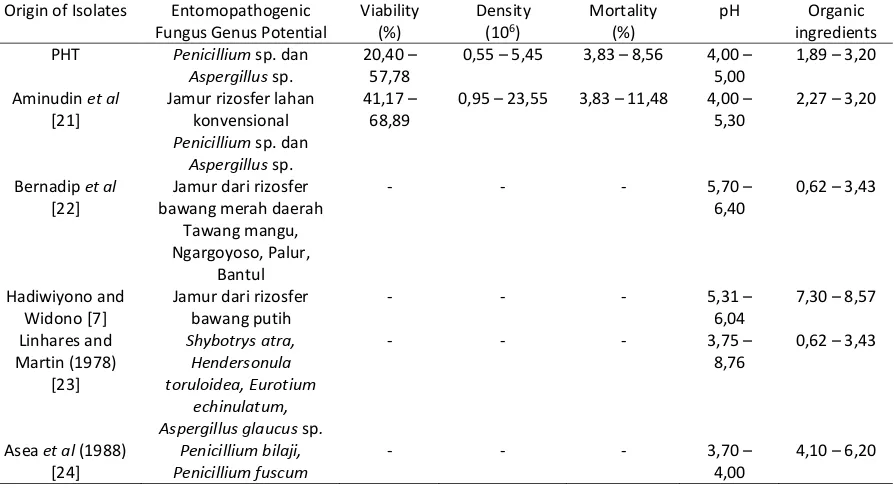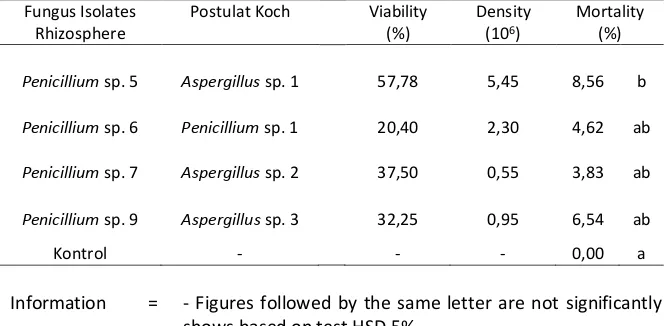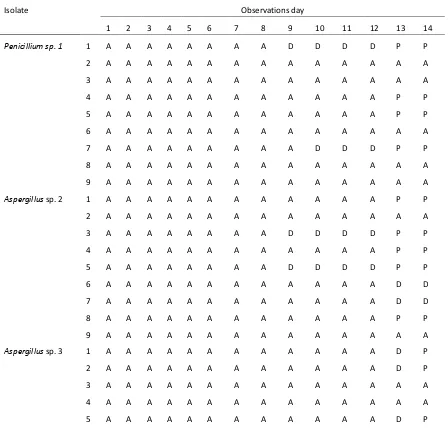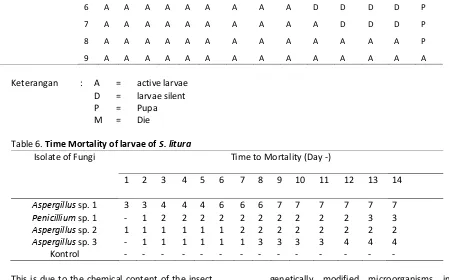36
Correlation of Soil Environmental to Diversity the Entomopathogenic Fungi
Rose Novita Sari Handoko 1, Aminudin Afandhi 2, Amin Setyo Leksono 3
1 Master Program of Environmental Resources Management and Development, Graduate Program, Brawijaya University 2 Faculty of Agriculture Science, Brawijaya University
3 Faculty Mathematics and Natural Science, Brawijaya University
Abstract
Ecosystem rice fields that have high diversity, able to control the pest. Habitat entomopathogenic fungi in the soil have been examined on cabbage plants but has not been reported in the rice field. The study was conducted through surveys of crops and paddy fields by the application of IPM in Kasembon Malang. A total of 5 points soil samples were determined diagonally used in this study. Isolation of entomopathogenic fungi from the rhizosphere of paddy is done by plate dilution method. Entomopathogenic fungi were identified to genus level by observing the macroscopic and microscopic characteristics. Koch's postulates done on Tenebrio molitor, then observe the symptoms and mortality of Spodoptera litura time pathogenicity test. The results showed that the genus of entomopathogenic fungi in the rhizosphere of rice is Penicillium sp., Aspergillus sp. and has not been identified. Chemical analysis of soil for pH is 4.00 to 5.00. Soil organic matter is 1.89% to 3.20%.
Keywords: diversity, entomopathogenic fungi, rhizosphere, integrated pest management
INTRODUCTION
High diversity of entomopathogenic fungus capable of controlling pest populations below the economic threshold. Intensive crop cultivation can reduce the diversity of entomopathogenic fungi [1,2]. High diversity of entomopathogenic fungi can protect plants from pests [3]. Ground role to protect entomopathogenic fungus from the influence of abiotic and biotic factors [4]. Control pest populations sustainably using entomopathogenic fungus.
The existence of the insect pathogenic fungi in the soil of cabbage plants on organic and conventional land adjacent showed no significant difference [5]. Fungal species were identified from the rhizosphere of cabbage plants are Beauveria bassiana, Fusarium merismoides, Metarhizium anisopliae and Tolypocladium cylindrosporum [5]. Application of organic fertilizer on farmland can increase the abundance of M. anisopliae. Organic manure as a substrate for mycelium EPF (entomopathogenic fungi) [4]. Fungi were isolated and identified from the rhizosphere of rice in Brazil are Penicillium sp., Aspergillus sp., Trichoderma sp.,
Cladosporium sp., Rhizopus sp. and
Westerdykella sp. [6].
Correspondence address:
Rose Novita Sari Handoko
Email : [email protected]
Address : Master Program of Environmental Resources Management and Development, Brawijaya University
Entomopathogenic fungus Beauveria bassiana on land that sorghum has a maximum radial growth at pH 7 [1]. states that the growth of Aspergillus sp. in the paddy field, which has a pH of 4.5 to 5 [1]. That the high population of microbial fungi (643.27 x 106 per gram of soil) on the plant rhizosphere of garlic because of the availability of organic matter (7.30%) were height and intensity of disease is low (0-10%) [7]. This study aimed to analyze the relationship between
pH and soil organic matter with
entomopathogenic fungal genus diversity in rice paddy Kasembon IPM in Malang.
MATERIAL AND METHOD
This study was conducted in August 2016 to
November 2016. Identification of
entomopathogenic fungi in the Laboratory of Microbiology Department of Biology, Faculty of Science, University of Malang, Koch's postulates and pathogenicity test in Nematologi and Entomology Laboratory of the Department of Plant Pests and Diseases Brawijaya University of Malang. Points of data collection is done in Mangir Hamlet, Village Sukosari, Kasembon District, Malang Regency. Description rice cultivation with IPM obtained from interviews with farmers who own the land.
Soil samples
method and conducted soil analysis per sample point.
Isolation of entomopathogenic fungi
Isolation of fungi carried by plate dilution method. Each field site soil samples were taken 25 g and diluted with 225 ml peptone ago in Fortex then obtained a 10-1 dilution. Suspension 10-1 dilution taken 1 ml and diluted with 9 ml peptone Fortex anaesthetized in the obtained dilution 10-2. Dilution continue dilakuakn to 10-5 dilution rate.
Before cultured in media Sabauraud Dextrose Agar Yeast Extract (SDAY) then any dilution carried Fortex in order dissolved. Each dilution rate of 0.1 ml is taken then cultured in media SDAY in a petri dish and then leveled. Dilution rate starting from 10-5 to 10-1, because it reduces the deposition on the tip on the micropipette. Furthermore incubated for 3 days in an incubator at a temperature of 35 ° C. Dilution activities done in Laminar Air Flow Cabinet (LAFC). After incubation observed on each cup. If there is more than one fungal colonies growing on a petri dish, then do purification. Furthermore incubated for 7 days in an incubator at a temperature of 35 ° C.
Making suspension Conidia
Entomopathogenic fungal isolates cultured in media SDAY for 7 days was transferred to potato dextrose media Extract Peptone (EKDP) with a composition of 1 liter of distilled water, 250 grams of potatoes, 20 grams of dextrose, 10
grams of peptone and 1 gram of
chloramphenicol). The transfer is done by taking 1 cm x 1 cm to 5 times of fungal isolates in SDAY, shaken and incubated for 7 days at 100 rpm at a temperature of 25 - 30oC. Furthermore, the fungus had grown on media shaken by hand and taken 10 ml falcon tube inserted into to centrifugation at 3000 rpm for 5 minutes to separate the pure conidia EKDP media. The supernatant was discarded and the pellets are left (sediment). Then pellets sterile distilled water plus 5 ml [9,10]. Conidia suspension can then be used for calculating the density and viability of conidia.
Data Collection
The results of the laboratory for chemical analysis of land attached in the form of tables,
mushroom Diversity analyzed using
keanekagaraman index (H') [11], density and viability of conidia [12]. Data pathogenicity analyzed using analysis of variance, what if the results show a marked influence then tested
further using Honestly Significant Difference at 5% level.
RESULT AND DISCUSSION Soil Chemical Analysis
Rhizosphere soil analyzes showed that the rice plants with the application of IPM has a degree of acidity (pH) of 4.00 to 5.00 (Table 1). While the organic material (BO) from 1.89 to 3.20 (Table 1).
Soil acidity (pH) is one of the important factors in the development of soil borne pathogens [13]. According [7], that the degree of soil acidity indirect effect on the lives of pathogenic soil because soil pH is closely related to soil chemical properties, including the availability of nutrients for plant pathogens. [7], states that soil with average acidity of 6.04, the intensity of the disease is low, while the soil with a soil pH of less than 5.5 higher incidence of the disease. Attack plant diseases can occur due to pest vectors that spread the disease. If the diversity of the entomopathogenic fungus high insect pests can be controlled and stable environment.
[7], that the high population of microbial fungi (643.27 x 106 per gram of soil) and bacteria (893.91 x 108 per gram of soil) because of the availability of organic matter (7.30%) is high in the soil and the intensity of the disease is low (0-10%). High organic matter content can increase biological activity of soil microbes, including microbes that are antagonistic to pathogens [14]. Postulat Koch
The death rate test insects to larvae of T. molitor is a parameter measuring the number of test larvae that die from entomopathogenic fungal infections of the rhizosphere of rice plant in the village Sukosari IPM system, Kasembon District, Malang Regency. The larvae used were fourth instar larvae (a body length of 0.61 cm) - 6 (total body length of 0.83 cm) [15]. Results of larval mortality rate calculation used to
determine the effectiveness of
entomopathogenic fungi in controlling insect pest population. The density used is 106.
38 molitor. Viability fungal isolates Penicillium sp. 5
that is 85,71%, Penicillium sp. 6 is 83,33%, Penicillium sp. 7 that is 66,67%, Penicillium sp. 9 yaitu 86,67%, ni identified is 76,92% (Tabel 3).
According [16], virulent isolates had higher viability than avirulent isolates. A fungus that grows on the body of T. molitor in isolation and subsequently transmitted to S. litura for pathogenicity test. Differences in virulence of entomopathogenic fungi caused by secondary metabolites produced by each fungi [17]. The genus Aspergillus produce aflatoxin [17]. The genus Penicillium meproduksi penicillin [17]. The optimum temperature for growth of of T. molitor larvae Koch's postulates hereinafter in pathogenicity test on larvae of S. litura cause the highest mortality is 8.56% of the genus Aspergillus sp. 1 (Table 4). The observation of symptoms in S. litura is a high mortality affecting mortality faster time is 1 day after observation.
Fungal isolates from the rhizosphere and Koch postulate test that can cause mortality of 4.64% ie Penicillium sp. 1. Time mortality ie 2 days after application isolate Penicillium sp. 1 (Table 5). Isolates of Penicillium sp. 1 is a
pathogen that can cause mortality that has been tested Koch's postulates and pathogenicity.
Koch postulate test carried out in two stages, namely reinokulasi and reisolasi of any isolates obtained. Mold growing on the larva were isolated and inoculated back as the early stages. Furthermore, the observation of the characteristics of the isolates and the results were compared with the initial isolates have been obtained [20].
The method was introduced by Robert Koch in 1884 has four requirements that must be met in order to prove whether a pathogen can actually cause disease in the host or not. All of these requirements must be met to be able to determine the relationship between disease-causing pathogens and their hosts.
The optimum temperature for growth of entomopathogenic fungus is 20-30oC [9] and a humidity of 80% [10]. Environmental factors such as temperature and humidity determine the virulence of entomopathogenic fungi. The mean temperature during the study pathogenicity test is 27,24oC and average humidity is 79.86%.
Host factors such as age also affect the mortality of larvae of insects by entomopathogenic fungi. Test insects used were second instar larvae of S. litura. According to [18] young larvae are more susceptible than larvae infected with entomopathogenic fungi that are old.
Table 1. Effect of Soil Chemical Factors against Entomopathogenic Fungus Origin of Isolates Entomopathogenic
Fungus Genus Potential Aspergillus glaucus sp.
Table 2. Postulat Koch larva T. molitor
Isolates of Fungi Viability (%) Density (106) Mortality (%) Pathogen/No
Penicillium sp. 1 75,00 0,65 0 a -
Penicillium sp. 2 71,43 0,25 0 a -
Penicillium sp. 3 75,00 1,55 0 a -
Aspergillus sp. 1 80,00 1,30 0 a -
Penicillium sp. 4 75,00 0,40 0 a -
P
Penicillium sp. 5 85,71 0,70 3,31 a
Penicillium sp. 6 83,33 0,95 3,31 a P
Penicillium sp. 7 66,67 0,15 3,31 a P
Penicillium sp. 8 66,67 1,05 0 a -
Penicillium sp. 9 86,67 0,70 3,31 a P
No Identification 76,92 0,30 3,31 a P
Kontrol 0 0 0 a -
Information = - Figures followed by the same letter are not significantly different behind shows based on test HSD 5%. - Data is transformed using arcsin
Table 3. Time to Mortality Larva T. molitor
Isolates of Fungi Time to Mortality (Day -)
1 2 3 4 5 6 7
Penicillium sp. 1 - - - - Penicillium sp. 2 - - - - Penicillium sp. 3 - - - - Aspergillus sp. 1 - - - - Penicillium sp. 4 - - - - Penicillium sp. 5 - - 1 - - - - Penicillium sp. 6 - 1 - - - - - Penicillium sp. 7 - - - - 1 - - Penicillium sp. 8 - - - - Penicillium sp. 9 - - - - 1 - -
No Identfication - - - 1 - - -
Kontrol - - - -
Table 4. S. litura larvae mortality after Koch's postulates of T. molitor Larva
Fungus Isolates Rhizosphere
Postulat Koch Viability (%)
Density (106)
Mortality (%)
Penicillium sp. 5 Aspergillus sp. 1 57,78 5,45 8,56 b
Penicillium sp. 6 Penicillium sp. 1 20,40 2,30 4,62 ab
Penicillium sp. 7 Aspergillus sp. 2 37,50 0,55 3,83 ab
Penicillium sp. 9 Aspergillus sp. 3 32,25 0,95 6,54 ab
Kontrol - - - 0,00 a
Information = - Figures followed by the same letter are not significantly different behind shows based on test HSD 5%.
40 Table 5. Symptoms of S. litura larvae observation for 14 days
Isolat Observations day
1 2 3 4 5 6 7 8 9 10 11 12 13 14
Aspergillus sp. 1 1 A A A A A A A A A A A A P P
2 A A A A M M M M M M M M M M
3 A A A A A A A A A A D P P P
4 A A A A A A A A A A P P P P
5 M M M M M M M M M M M M M M
6 A A A A A A A A A A A A P P
7 A A A A A A A A A A D P M M
8 A A A A A A A A A D D P P P
9 A A A A A A A A A D D P P P
Table 5. (Advanced) Symptoms of S. litura larvae observation for 14 days
Isolate Observations day
1 2 3 4 5 6 7 8 9 10 11 12 13 14
Penicillium sp. 1 1 A A A A A A A A D D D D P P
2 A A A A A A A A A A A A A A
3 A A A A A A A A A A A A A A
4 A A A A A A A A A A A A P P
5 A A A A A A A A A A A A P P
6 A A A A A A A A A A A A A A
7 A A A A A A A A A D D D P P
8 A A A A A A A A A A A A A A
9 A A A A A A A A A A A A A A
Aspergillus sp. 2 1 A A A A A A A A A A A A P P
2 A A A A A A A A A A A A A A
3 A A A A A A A A D D D D P P
4 A A A A A A A A A A A A P P
5 A A A A A A A A D D D D P P
6 A A A A A A A A A A A A D D
7 A A A A A A A A A A A A D D
8 A A A A A A A A A A A A P P
9 A A A A A A A A A A A A A A
Aspergillus sp. 3 1 A A A A A A A A A A A A D P
2 A A A A A A A A A A A A D P
3 A A A A A A A A A A A A A A
4 A A A A A A A A A A A A A A
6 A A A A A A A A A D D D D P
7 A A A A A A A A A A D D D P
8 A A A A A A A A A A A A A P
9 A A A A A A A A A A A A A A
Keterangan : A = active larvae D = larvae silent
P = Pupa
M = Die
Table 6. Time Mortality of larvae of S. litura
Isolate of Fungi Time to Mortality (Day -)
1 2 3 4 5 6 7 8 9 10 11 12 13 14
Aspergillus sp. 1 3 3 4 4 4 6 6 6 7 7 7 7 7 7
Penicillium sp. 1 - 1 2 2 2 2 2 2 2 2 2 2 3 3
Aspergillus sp. 2 1 1 1 1 1 1 2 2 2 2 2 2 2 2
Aspergillus sp. 3 - 1 1 1 1 1 1 3 3 3 3 4 4 4
Kontrol - - - -
This is due to the chemical content of the insect cuticle changes gradually with age resulting larvae cuticle hardening and increased humoral immunity against entomopathogenic fungal infections [19].
According [20], stated that the inclusion of insecticide into the insect's body can be in three parts, one of which is the surface of the body (skin). [3], states that the toxic compounds contained in the fungal spores into direct contact with the surface of the larva's body, resulting in disruption of the body's metabolism. Disruption of the body's metabolism can lead to death and this depends on the fungus used. Virulent fungus that would cause a faster mortality (Table 10). Insects infected will usually stop eating that causes decreased immunity [17].
ACKNOWLEDGEMENT
Thanks go to Dr. Ir. Aminudin Afandhi, MS., Amin Setyo Leksomo S.Si., M. Si., Ph.D., Mufidah Afiyanti, SP., Ph.D., Irfan Mustafa S.Si., M. Si., Ph.D., Dr. Bagyo Yanuwiadi who has guided the research. The research was funded by Dana Pagu Anggaran PNBP dengan Surat Perjanjian 814b/UN10.14/PG/.
REFERENCES
[1]. Dighton J, Jones HE, Robinson CH, Beckett J. 1997. The role of abiotic factors, cultivation practices and soil fauna in the dispersal of
genetically modified microorganisms in soils. Applied Soil Ecology 5: 109-131. [2]. Paoletti MG, Pimentel D, Stinner BR, Stinner
D. 1992. Agroecosystem biodiversity: Matching production and conservation biology. Agriculture, Ecosystems & Environment 40: 3-23.
[3]. Meyling, Nicolai, V., Kristensen, Kristian, Thorup., Eilenberg, Jorgen. 2011. Below-
and aboveground abundance and
distribution of fungal entomopathogens in experimental conventional and organic cropping systems. J. Biological Control 59: 180-186.
[4]. Moraga, Q. E., J.A. Navas-Cortes, E.A.A. Maranhao, A. Ortiz-Urquiza, C. Santiago-Alvarez. 2007. Factors Affecting The Occurrence and Distribution of Entomopathogenic Fungi in Natural and Cultivated Soils. Mycological Research 111: 947-966.
[5]. Klingen, Ingeborg., Eilenberg, Jorgen., Meadow, Richard. 2002. Effects of farming system, field margins and bait insect on the occurrence of insect pathogenic fungi in soils. J. Agriculture, Ecosystems and Environment 91: 191-198.
42 Procedure for Inorganic-As Remediation
Based on The Use of Fungi Isolated from Rice Rhizosphere. Journal of Environmental Chemical Engineering 4: 891-898.
[7]. Hadiwiyono dan Widono. 2008. Hubungan Faktor Lingkungan Tanah terhadap Intensitas Busuk Pangkal Bawang Putih di Tawangmangu. Agrin Vol 12. No.1: 15-22. [8]. Trizelia, Armon, N., Jailani, H. 2015.
Keanekaragaman Cendawan
Entomopatogen pada Rizosfer berbagai Tanaman Sayuran. Fakultas Pertanian. Universitas Andalas. Sumatera Barat. Vol. 1. No. 5:998-1004.
[9]. Hsia, I.C.C., M.T. Islam, Y. Ibrahim, T.Y. Howand D. Omar, 2014. Evaluation of Conidial Viability of Entomopathogenic Fungi as Influenced by Temperature and
Additive. Int. J. Agric. Biol., 16: 146‒152.
[10].Namasivayam, S.K.R., R. Aarthi, P. Anbazhahan. 2005. Studies on Factors
Influencing the Viability of
Entomopathogenic Fungi Metarhizium anisopliae in Soil Adapting Culture Dependent Method. J. Biopest. 8(1): 23-27. [11]. Krebs, J. R., Wilson, J. D., Bradbury, R. B., &
Siriwardena, G. M. (1999). The second silent spring. Nature, 400(6745), 611–612. [12]. Herlinda, S., M.D. Utama, Y. Pujiastuti,
Suwandi. 2006. Kerapatan dan Viabilitas Spora Beauveria bassiana (Bals.) akibat Subkultur dan Pengayaan Media serta Virulensinya terhadap Larva Plutella xylostella (Linn.). J. HPT Tropika 6(2): 70-78. [13]. Koike, S.T., K.V. Subbarau, R.M. Davis, T.A.
Turini. 2008. Vegetable disease caused by soilborn pathogens. ANRPublication 8099. [14]. Mazzola, M. 2004. Assessment and
Management of Soil Microbial Community Structure For Disease Suppression. Phytopathology 4(2):35-59.
[15]. Park, J.B., W.H. Choi, S.H. Kim, H.J. Jin, Y.S. Han, Y.S. Lee dan N.J. Kim. 2014. Developmental Characteristic of Tenebrio molitor Larvae (Coleoptera: Tenebrionidae) in Different Instar. Int. J. Indust. Entomol. 28 (1) 5-9.
[16]. Trizelia. 2005. Cendawan Entomopatogen Beauveria bassiana: Keragaman Genetik, Karakterisasi Fisiologi dan Virulensinya Terhadap Crocidolomia pavonana. [Disertasi]. Institut Pertanian Bogor, Bogor.
[17]. Paterson R.R.M. 2006. Fungi and Fungal Toxins as Weapons. Mycological Resesearch Journal. 110: 1003-1010.
[18]. Ramzan-Asi, M., M.H. Bashir, M. Afzal, M. Ashfaq, S.T. Sahi. 2010. Compatibility of Entomopathogenic Fungi, Metarhizium anisopliae and Paecilomyces fumosoroseus With Selective Insecticides. Pak. J. Bot. 42(6): 4207-4214.
[19]. Boman, H.G. 1980. Insect Responses for Microbial Infections. p 769-784. In Burges, H.D (ed.), Microbial Control of Pests and Plant Diseases. Academic Press, New York. [20]. Sanjaya, Y. Nurhaeni, H. Halima, M. 2010.
Isolasi, Identifikasi dan Karakterisasi Jamur Entomopatogen dari Larva Spodoptera litura (Fabricius). Jurnal Ilmu-ilmu Hayati dan Fisik. Vol. 12. No. 3: 136-141.
[21]. Aminudin, A. Leksono, A. S. Afiyanti, M., Handoko, R. N. S. 2016. Keanekaragaman Jamur Entomopatogen pada Rizosfer Tanaman Padi (Oryza sativa L.) dengan Sistem Konvensional di Kasembon Malang. Laporan Penelitian Dana Pagu Anggaran PNBP. Universitas Brawijaya, Malang. [22]. Bernadip, B. R., Hawiwiyono, Sudadi. 2014.
Keanekaragaman Jamur dan Bakteri Rizosfer Bawang Merah terhadap Patogen Moler. Jurnal Ilmu Tanah dan Agroklimatologi: 52-60.
[23]. Linhares, L. F., and J. P. Martin. 1978. Decomposition in soil of the humic acid-type melanins of Eurotium echinulatum, Aspergillus glaucus sp. and other fungi. Journal Soil Sci. Soc. Am. 42: 738-743. [24]. Asea, P. E. A., Kucey, R.M.N., Stewart, J.W.B.



